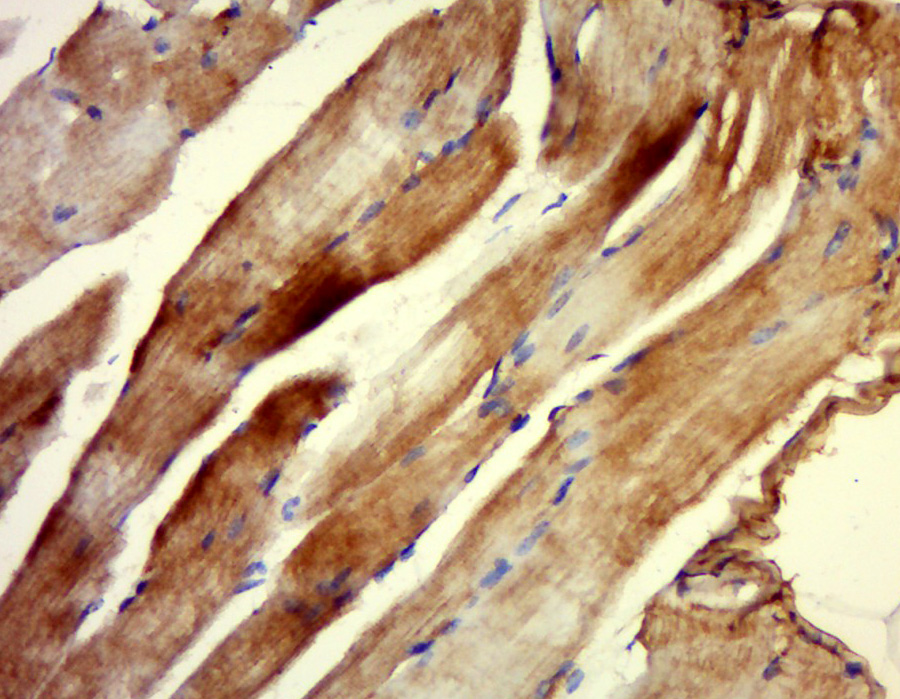
Rabbit Anti-NDUFS7 antibody
CI 20; CI-20kD; Complex I 20kDa subunit; Complex I mitochondrial respiratory chain 20 KD subunit; Complex I-20kD; MGC120002; MY017; NADH coenzyme Q reductase; NADH dehydrogenase (ubiquinone) Fe S protein 7 20kDa (NADH coenzyme Q reductase); NADH dehydroge
View History [Clear]
Details
Product Name NDUFS7 Chinese Name Mitochondrion复合物NDUFS7蛋白抗体 Alias CI 20; CI-20kD; Complex I 20kDa subunit; Complex I mitochondrial respiratory chain 20 KD subunit; Complex I-20kD; MGC120002; MY017; NADH coenzyme Q reductase; NADH dehydrogenase (ubiquinone) Fe S protein 7 20kDa (NADH coenzyme Q reductase); NADH dehydrogenase (ubiquinone) FeS protein 7, 20kDa (NADHcoenzyme Q reductase); NADH dehydrogenase (ubiquinone) FeS protein7, 20kDa (NADHcoenzyme Q reductase); NADH dehydrogenase [ubiquinone] iron-sulfur protein 7, mitochondrial; NADH-ubiquinone oxidoreductase 20 kDa subunit; NADH:ubiquinone oxidoreductase PSST subunit; NADHcoenzyme Q reductase; Ndufs7; NDUS7_HUMAN; PSST; PSST subunit. Research Area Tumour Cell biology Neurobiology Signal transduction The new supersedes the old Immunogen Species Rabbit Clonality Polyclonal React Species Mouse, (predicted: Human, Rat, Chicken, Dog, Pig, Cow, Horse, ) Applications ELISA=1:5000-10000
not yet tested in other applications.
optimal dilutions/concentrations should be determined by the end user.Theoretical molecular weight 20kDa Cellular localization cytoplasmic Form Liquid Concentration 1mg/ml immunogen KLH conjugated synthetic peptide derived from human NDUFS7: 101-160/213 Lsotype IgG Purification affinity purified by Protein A Buffer Solution 0.01M TBS(pH7.4) with 1% BSA, 0.03% Proclin300 and 50% Glycerol. Storage Shipped at 4℃. Store at -20 °C for one year. Avoid repeated freeze/thaw cycles. Attention This product as supplied is intended for research use only, not for use in human, therapeutic or diagnostic applications. PubMed PubMed Product Detail Located in the mitochondrial inner membrane, mitochondrial complex I is the first and largest enzyme in the electron transport chain of oxidative phosphorylation. By oxidizing NADH that is produced in the Krebs cycle, this complex utilizes the two electrons to reduce ubiquinone to ubiquinol, thereby initiating the passage of electrons to successive complexes and ultimately leading to the reduction of oxygen to water. Mitochondrial complex I consists of over 40 subunits and is of considerable clinical interest since defects in any of the subunits can lead to various myopathies and neuropathies. As a subunit of mitochondrial complex I, NDUFS7 (NADH dehydrogenase [ubiquinone] iron-sulfur protein 7), also designated NADH-ubiquinone oxidoreductase 20 kDa subunit, is a 213 amino acid protein that is suggested to be required for catalytic activity. Defects in the gene encoding NDUFS7 are the cause of Leigh syndrome, a severe neurological disorder that is characterized by bilaterally symmetrical necrotic lesions in subcortical brain regions.
Function:
Core subunit of the mitochondrial membrane respiratory chain NADH dehydrogenase (Complex I) that is believed to belong to the minimal assembly required for catalysis. Complex I functions in the transfer of electrons from NADH to the respiratory chain. The immediate electron acceptor for the enzyme is believed to be ubiquinone.
Subunit:
Complex I is composed of 45 different subunits This is a component of the iron-sulfur (IP) fragment of the enzyme.
Subcellular Location:
Mitochondrion.
DISEASE:
Defects in NDUFS7 are a cause of Leigh syndrome (LS) [MIM:256000]. LS is a severe neurological disorder characterized by bilaterally symmetrical necrotic lesions in subcortical brain regions. Defects in NDUFS7 are a cause of mitochondrial complex I deficiency (MT-C1D) [MIM:252010]. A disorder of the mitochondrial respiratory chain that causes a wide range of clinical disorders, from lethal neonatal disease to adult-onset neurodegenerative disorders. Phenotypes include macrocephaly with progressive leukodystrophy, non-specific encephalopathy, cardiomyopathy, myopathy, liver disease, Leigh syndrome, Leber hereditary optic neuropathy, and some forms of Parkinson disease.
Similarity:
Belongs to the complex I 20 kDa subunit family.
SWISS:
O75251
Gene ID:
374291
Database links:
Entrez Gene: 374291 Human
Omim: 601825 Human
SwissProt: O75251 Human
Unigene: 211914 Human
Product Picture
Bought notes(bought amounts latest0)
No one bought this product
User Comment(Total0User Comment Num)
- No comment



 +86 571 56623320
+86 571 56623320
 +86 18668110335
+86 18668110335

